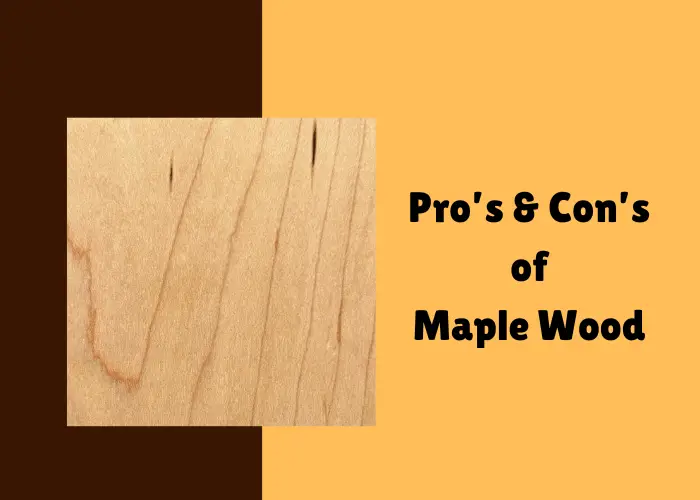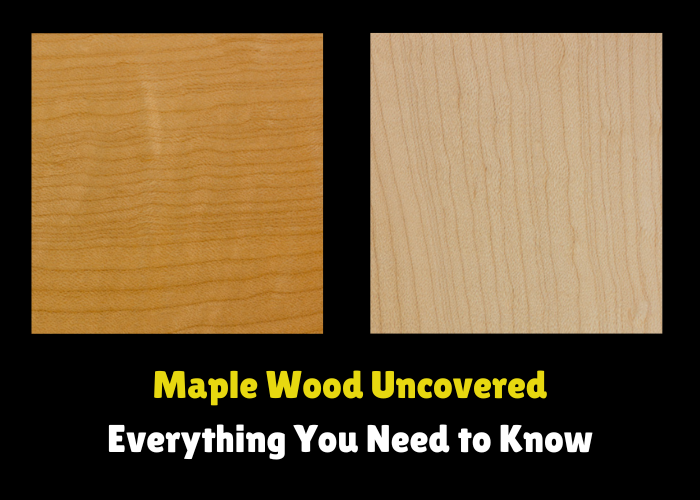Maple Wood
Globally, hardwood that is widely used and versatile is Maple wood. It is obtained from the maple tree, which is native to North America, Europe and parts of Asia. . As there are many species of maple trees, so there are different properties of each species maple wood.
If you’re working on a woodworking project or plan to acquire new furniture or high-quality flooring materials, anything to do with maple wood, knowing about its types, properties and uses will help you in making decisions.
Characteristics and Properties of Maple Wood
Below are the key characteristics and properties of maple wood, with a focus on hard maple, which is the most commonly used type.
General Characteristics
Color:
Sapwood: It ranges from nearly white to off-white, sometimes with a reddish or golden color.
Heartwood: It is darker reddish-brown, often with mineral streaks that can enhance its appearance.
Grain and Texture:
Typically straight-grained with a fine, uniform texture. However, it can also exhibit figured patterns such as birdseye, curly, or quilted grain.
The fine texture makes it easy to work with, although figured varieties may require more skill in handling.
Mechanical Properties
Hardness:
Hard maple has a Janka hardness rating of approximately 1,450 lbf (6,450 N), making it one of the hardest domestic hardwoods available.
Strength:
Modulus of Rupture (MOR): 10,700 psi
Modulus of Elasticity (MOE): 1,450,000 psi.
Density:
Average density is around 755 kg/m³, classifying it as a medium-weight hardwood.
Durability and Resistance
Durability:
Rated as slightly resistant to heartwood decay; however, it is susceptible to insect attack and not considered highly durable in outdoor applications.
Water and Shock Resistance:
Maple wood is known for its water resistance and shock resistance, making it suitable for various indoor and some outdoor projects.
Workability
Machining:
Generally easy to work with using both hand and power tools; however, the higher density can lead to blunting of cutting edges.
Finishing:
Maple takes stains well but may require pre-conditioning to prevent blotching. It polishes to a high sheen and holds nails effectively
Hard Maple vs Soft Maple
There are two basic categories of maple wood: hard maple and soft maple. Although both are different species from the same genus of trees (Acer), their physical properties and uses differ significantly from each other.
1. Defining Hard Maple (Sugar Maple)
Hard maple, also known as sugar maple (Acer saccharum) is a dense and resilient wood valued for its hardness. It is commonly used to make furniture, cabinetry and flooring because of its durability. The wood has a fine, uniform grain and is pale in color, from light cream to light reddish-brown. Sugar maple is best known for its role in manufacturing syrup, which makes it economically important in much of North America.
2. Defining Soft Maple (Red Maple, Silver Maple)
Soft maple, on the other hand, consists of the likes of the red maple (Acer rubrum) and silver maple (Acer saccharinum). Considered less dense and lighter in weight than hard maple, these maples are also easier to work with. Soft maple wood is a little rougher grain-wise, and can vary from a light yellow to reddish-brown color. Soft maple is usually reserved for more decorative pieces or less durable things like veneer, molding, or plywood.
3. Hard Maple vs Soft Maple: Key Differences
The primary differences between hard and soft maple are:
Density: Being denser and stronger, hard maple is perfect for high-traffic areas and heavy-duty applications such as flooring and furniture. Soft maple is less dense and softer, which makes it easier to cut and shape.
Durability: Hard maple is a very hard wood that will stand up to wear and tear, while soft maple is softer and more prone to dents and scratches.
Cost: Hard maple is usually pricier since it is durable and strong; on the other hand, soft maple is more inexpensive than hard maple.
Also read: Maple vs Cherry Wood: Which Should You Use ?
Popular Species of Maple Trees
Maple trees produce wood with distinctive attributes depending on the species. Some species are valued due to their hardness and strength, while others are more popular for their visual attractiveness or workability.
1. Sugar Maple (Acer saccharum)
The most sought-after hard maple species is sugar maple. Highly prized for its durability, smooth grain and light color, it is also used extensively to create quality furniture, cabinetry and flooring. Sugar maple is also renowned for its maple syrup, making it an better timber source and agricultural resource.
2. Red Maple (Acer rubrum)
It is one of the most commonly found soft maple species in North America. Its wood is much softer than sugar maple and has a pale, reddish color. It’s popular for making veneer, millwork and some furniture, although it is typically less durable than hard maple.
3. Silver Maple (Acer saccharinum)
Silver maple is a quicker growing tree but has softer wood than sugar maple. Wood of this is light, coarse and uneven grain. Not quite as dense as hard maple, it’s used in the making of musical instruments and occasionally furniture that doesn’t undergo heavy wear.
4. Black Maple (Acer nigrum)
Black maple, which retains many of the qualities of the sugar maple, is closely related. Its wood is dense and hard. Black maple tends to be harder to find than other types, but it offers a similar appearance and durability.
5. Boxelder Maple (Acer negundo)
Boxelder maple is less common and is often considered a “soft” maple.It is lightweight wood frequently used for construction where sturdiness is not needed, such as low-end furniture and boxes or craft projects. A soft timber, boxelder maple is easy to carve, and woodworkers have been known to use it for creative projects.
Maple Wood vs Other Wood Types
| Property | Maple (Hard Maple) | Oak (Red/White) | Birch |
| Janka Hardness | 1,450 lbf | 1,290 – 1,360 lbf | 1,260 lbf |
| Appearance | Smooth, subtle grain | Prominent grain | Fine grain |
| Workability | Moderate difficulty | Moderate difficulty | Easy |
| Cost | Affordable | Slightly higher | Similar to maple |
| Best Uses | Flooring, cabinetry | Furniture, cabinetry | Furniture, interior elements |
Pros and Cons of Maple Wood

Maple wood is a popular choice for various applications, especially in flooring, cabinetry, and furniture. Below are the key advantages and disadvantages of using maple wood.
Pros of Maple Wood
Aesthetic Appeal:
Maple has a very subtle grain pattern and light color that brightens spaces. Its uniformity enables it to be a part of multiple interior designs and aesthetics.
Allergen-Friendly:
Unlike carpets, maple wood does not harbor allergens such as dust mites or pet dander, making it an excellent choice for individuals with allergies.
Eco-Friendly:
They grow relatively quickly, too, compared with other hardwoods (like oak or walnut): more sustainable.
Cons of Maple Wood
Susceptibility to Moisture:
Maple is reactive to temperature and humidity hence it’s important to keep it well maintained as improper upkeep may cause it to cup or warp. This requires careful environmental control around its operating environment.
Scratches Easily:
Maple being durable while being denser than many hardwoods, it is still susceptible to scratches and dents, especially in high-traffic areas. Scratches will likely be more visible because of the light color of the wood as well as many other wood choices.
Discoloration Over Time:
Excessive sunlight exposure can turn maple wood a yellowish color or deepen the color over time, which some homeowners may find undesirable.
Difficulty in Staining:
Maple can be challenging to stain evenly due to its dense grain structure, which may result in blotchy appearances if not done correctly.
Cost:
Although generally affordable compared to some exotic hardwoods, high-quality maple can still be pricier than other options like pine or laminate flooring.
Frequently Asked Questions
1. Is Maple a Hardwood?
Yes, all types of maple wood are considered hardwoods. It includes both the hard maple (sugar maple) and soft maple species.
2. What Are the Main Types of Maple Wood?
The primary types of this wood include:
- Hard Maple (Sugar Maple): Known for its density and strength.
- Soft Maple: Includes varieties like red maple and silver maple, which are easier to work with but less durable.
- Birdseye Maple: Recognized for its unique swirling patterns.
- Quilted Maple: Features intricate quilt-like patterns.
3. Is Maple Wood Good for Furniture?
Yes, maple wood is a common choice for furniture because it is both strong and visually appealing. It has durable nature that resists wear and tear.
4. Can Maple Wood Be Used Outdoors?
Maple can be used outdoors but should only be done with proper treatment. Maple is susceptible to a great deal of moisture damage and insect damage, so maple is not as good for outdoor applications than other hardwoods like oak.
5. How Long Does Maple Wood Last?
With proper care and maintenance, maple wood can last for many years.
6. How Easy Is It to Work With Maple Wood?
Maple wood is relatively easy to work with using both hand and machine tools. However, depending on its density it can be difficult to carve or plane against the grain without blunting tools.

